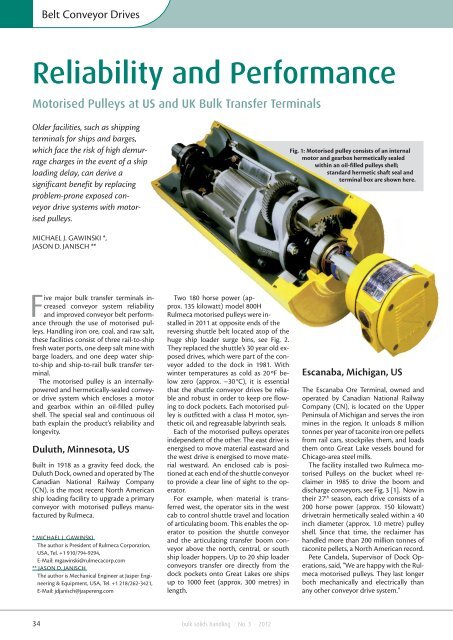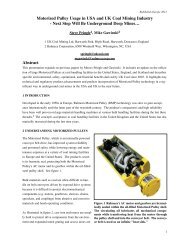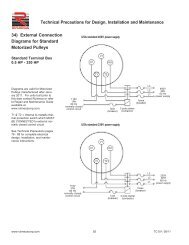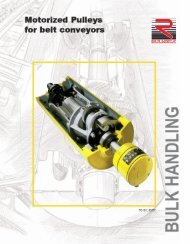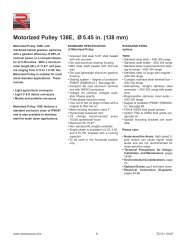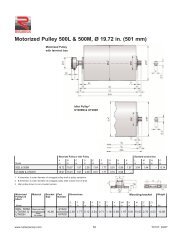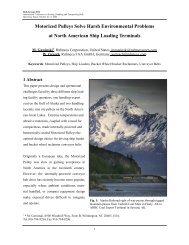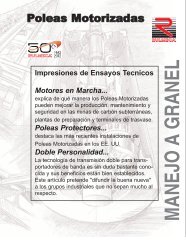full story - Rulmeca Corporation
full story - Rulmeca Corporation
full story - Rulmeca Corporation
You also want an ePaper? Increase the reach of your titles
YUMPU automatically turns print PDFs into web optimized ePapers that Google loves.
Belt Conveyor DrivesReliability and PerformanceMotorised Pulleys at US and UK Bulk Transfer TerminalsOlder facilities, such as shippingterminals for ships and barges,which face the risk of high demurragecharges in the event of a shiploading delay, can derive asignificant benefit by replacingproblem-prone exposed conveyordrive systems with motorisedpulleys.Fig. 1: Motorised pulley consists of an internalmotor and gearbox hermetically sealedwithin an oil-filled pulleys shell;standard hermetic shaft seal andterminal box are shown here.MICHAEL J. GAWINSKI *,JASON D. JANISCH **Five major bulk transfer terminals increasedconveyor system reliabilityand improved conveyor belt performancethrough the use of motorised pulleys.Handling iron ore, coal, and raw salt,these facilities consist of three rail-to-shipfresh water ports, one deep salt mine withbarge loaders, and one deep water shipto-shipand ship-to-rail bulk transfer terminal.The motorised pulley is an internallypoweredand hermetically-sealed conveyordrive system which encloses a motorand gearbox within an oil-filled pulleyshell. The special seal and continuous oilbath explain the product’s reliability andlongevity.Duluth, Minnesota, USBuilt in 1918 as a gravity feed dock, theDuluth Dock, owned and operated by TheCanadian National Railway Company(CN), is the most recent North Americanship loading facility to upgrade a primaryconveyor with motorised pulleys manufacturedby <strong>Rulmeca</strong>.* MICHAEL J. GAWINSKIThe author is President of <strong>Rulmeca</strong> <strong>Corporation</strong>,USA, Tel. +1 910/794-9294,E-Mail: mgawinski@rulmecacorp.com** JASON D. JANISCHThe author is Mechanical Engineer at Jasper Engineering& Equipment, USA, Tel. +1 218/262-3421,E-Mail: jdjanisch@jaspereng.comTwo 180 horse power (approx.135 kilowatt) model 800H<strong>Rulmeca</strong> motorised pulleys were installedin 2011 at opposite ends of thereversing shuttle belt located atop of thehuge ship loader surge bins, see Fig. 2.They replaced the shuttle’s 30 year old exposeddrives, which were part of the conveyoradded to the dock in 1981. Withwinter temperatures as cold as 20 ºF belowzero (approx. –30 °C), it is essentialthat the shuttle conveyor drives be reliableand robust in order to keep ore flowingto dock pockets. Each motorised pulleyis outfitted with a class H motor, syntheticoil, and regreasable labyrinth seals.Each of the motorised pulleys operatesindependent of the other. The east drive isenergised to move material eastward andthe west drive is energised to move materialwestward. An enclosed cab is positionedat each end of the shuttle conveyorto provide a clear line of sight to the operator.For example, when material is transferredwest, the operator sits in the westcab to control shuttle travel and locationof articulating boom. This enables the operatorto position the shuttle conveyorand the articulating transfer boom conveyorabove the north, central, or southship loader hoppers. Up to 20 ship loaderconveyors transfer ore directly from thedock pockets onto Great Lakes ore shipsup to 1000 feet (approx. 300 metres) inlength.Escanaba, Michigan, USThe Escanaba Ore Terminal, owned andoperated by Canadian National RailwayCompany (CN), is located on the UpperPeninsula of Michigan and serves the ironmines in the region. It unloads 8 milliontonnes per year of taconite iron ore pelletsfrom rail cars, stockpiles them, and loadsthem onto Great Lake vessels bound forChicago-area steel mills.The facility installed two <strong>Rulmeca</strong> motorisedPulleys on the bucket wheel reclaimerin 1985 to drive the boom anddischarge conveyors, see Fig. 3 [1]. Now intheir 27 th season, each drive consists of a200 horse power (approx. 150 kilowatt)drivetrain hermetically sealed within a 40inch diameter (approx. 1.0 metre) pulleyshell. Since that time, the reclaimer hashandled more than 200 million tonnes oftaconite pellets, a North American record.Pete Candela, Supervisor of Dock Operations,said, "We are happy with the <strong>Rulmeca</strong>motorised pulleys. They last longerboth mechanically and electrically thanany other conveyor drive system."34bulk solids handling · No. 3 · 2012
Belt Conveyor DrivesAvery Island, Louisiana, USFig. 2: The Duluth Dock ship loader conveyors load ships at up to 10000 tonnes per hour (left). Ashuttle conveyor transfers ore from ground storage into 60 hoppers in dock; the close-up of theWest end of the shuttle conveyor (right) shows the 180 horse power (approx. 135 kilowatt) <strong>Rulmeca</strong>motorised pulley discharging ore into north hopper via articulating boom.Some 1200 miles (approx. 1900 kilometres)south of Duluth in the swampy regionof Avery Island, Louisiana, CargillDeicing operates a salt mine and bargeloading terminal. The deep mine has battledthe effects of corrosion and abrasionsince the mine shaft was first sunk into thehuge salt dome in 1862.Operations and maintenance personneluse stainless steel, special paint, andwooden structures to combat corrosiondue to salt accumulation in the humidLouisiana marshlands. However, it was notuntil Everett McBride first tried <strong>Rulmeca</strong>motorised pulleys in the barge loadingsystem in 2004 that the company beganseriously converting their exposed conveyordrive systems to internally-poweredconveyor drive pulleys.Now the mine enjoys higher system reliabilityand lower maintenance expensebecause the pulleys enclose all drive componentswithin an oil filled hermeticallysealedpulley shell. Rather than strugglingto protect moving components, Cargill"hides" them out of harm’s way, see Figs. 4and 5.Cargill has standardised on three <strong>Rulmeca</strong>motorised pulley models (i.e. 500M,630H, and 800H) to limit the number ofspares protecting the system. This is possiblebecause only two different beltwidths are used in the entire barge loadingsystem.The models are: 500M at 20 horse power(approx. 15 kilowatt) and 480 feet perminute (approx. 2.4 metres per second)with 31.5 inch (approx. 0.8 metre) facewidth, 630H at 60 horse power (approx.45 kilowatt) and 600 feet per minute (approx.3 metres per second) with 37.4 inch(approx. 0.95 metre) face width, and 800Hat 75 horse power (approx. 56 kilowatt)and 480 feet per minute (approx. 2.45 metresper second) with 45.28 inch (approx.1.15 metre) face width.Cargill Deicing operations and maintenancepersonnel have been very satisfiedwith the motorised pulleys' performanceand are pleased that formerly exposeddrive components are now out of sightand out of mind.Special features incorporated into theCargill motorised pulleys include inorganiczinc rich primer, 12 mils (approx. 0.3millimetre) of Carboline CarbomasticCM15FC paint, regreasable labyrinth seals,and stainless steel shafts. The paint systemprotects steel and cast iron surfaces whilethe labyrinth seals provide a grease barrierto protect all double lip shaft seals. In addition,Class H motors and synthetic oilprotect the drive system from the heat ofthe Louisiana marshland climate.Fairlie, Largs, Scotland, UKAcross the Atlantic Ocean, 4500 miles(approx. 7200 kilometres) from Avery Island,Clydeport upgraded its ship loaderconveyor drives and primary dock con-Fig. 3: Installed in 1985,the two <strong>Rulmeca</strong> motorisedpulleys working inthe bucket wheel reclaimerat Escanaba Ore Terminalare now in their 27thshipping season.veyor with motorised pulleys delivered by<strong>Rulmeca</strong> in 2011 and 2012 at the HunterstonTerminal in Fairlie, Largs, Scotland.This follows several years of successfultesting of <strong>Rulmeca</strong> drives elsewhere at thefacility. Capable of unloading 350 000 dwtcape size vessels and loading 95 000 dwtvessels, the Hunterston Terminal has thefastest discharging rates in the UK and iskeenly aware of the risk of demurrage feesif the terminal’s conveyor system were todelay coal loading or unloading.Ideally located for UK, Irish, and Europeancoal markets, Hunterston also offersrail and road links. With a promise ofmore reliable "up time" plus a reduction inenergy costs, the motorised pulley madeits debut in 2008 on a secondary conveyordrive in the terminal’s rapid train loadingstation.Two additional drives were installed inthe train loading station in October 2009,this time on the primary circuit, making atotal of three 100 horse power (approx. 75kilowatt) 600 feet per minute (approx. 3metres per second) model 800H units inthe bunker feed system [2]. Hunterston’sshifts maintenance manager, Willie Caig,said "We’ve run the <strong>Rulmeca</strong> pulleys in thetrain loader on and off 24 hours a day, dependingon coal demand, without anyproblems. We look forward to the samegood product performance when we fitthe big drives onto our ship loader and exportdock conveyor."With regreasable labyrinth seals, ceramiclagging, and internal backstops, Hunterston’snew ship loader and dock conveyordrives will offer high product and personnelprotection in the harsh salt water environment.In addition to two clamshellship unloaders, a shiploader, and a trainloadout station, Hunterston Terminal hasa 120 acre (485 000 square metre) coalstockyard serviced by three bucket wheelPictures: <strong>Rulmeca</strong> <strong>Corporation</strong>bulk solids handling · No. 3 · 2012 35
Belt Conveyor Drivesstacker reclaimers, operating 24 hours/day, 7 days/week.Superior, Wisconsin, USFig. 6: One of three 40 year old 4000 tonne perhour bucket wheel reclaimers upgraded byBNSF with three <strong>Rulmeca</strong> motorised pulleys(one on boom and two on tail.)Located in the greater Duluth area, the AllouezDock, owned and operated by BNSFRailway, installed three <strong>Rulmeca</strong> motorisedpulleys to upgrade conveyor driveson a forty year old bucket wheel reclaimerin 2004, see Fig. 6 [1]. Since that time theterminal installed six more motorised pulleysupgrading two additional reclaimersand three motorised pulleys upgradingthe train unloader. After five seasons ofuse, Gary Kucharyski, Allouez Dock MaintenanceSupervisor, said, "The use of twomotorised pulleys on each of our three reclaimerdischarge conveyors has enabledus to reduce slack side tension and increasethe service life of our belts. We arepleased not only with the reliability of our<strong>Rulmeca</strong> motorised Pulleys but also withthe extended belt life they have yielded."As shown in Fig. 7, the dual drive systemis "nested" beneath the discharge conveyor.The serpentine arrangement yielded420 degrees of belt wrap, significantlymore than the original 180 degrees. Calculationsshowed that the additional 240degrees of belt wrap reduced slack sidetension to prevent belt slippage and/orsag, T2, by 29 percent. This drop in T2 resultedin a reduction of 13 percent in T1,total belt tension.Nesting a dual drive onto a reclaimerwas a new idea in 2004, but undergroundcoal mines have used dual drive systems ina serpentine arrangement for many yearsas booster drives to spread "effective belttension" (Te) along the length of the conveyorinstead of concentrating all effectivetension at the discharge end of the conveyor.Minimising the amount of tensionthat a conveyor belt must withstand reducesits weight, which is essential to assemblingand relocating conveyors undergroundefficiently [3].ConclusionOlder facilities, such as shipping terminalsfor ships and barges, which face the risk ofhigh demurrage charges in the event of aFig. 7: The “nested dual drive” arrangementwith two motorised pulleys yielded 420º degreeof belt wrap, reducing slack side tensionrequirement by 29 percent.Fig. 4: An original conveyordrive system at Cargill’sAvery Island operationswith exposed motor, gearbox,and chain/sprocketassembly.Fig. 5: By replacing theoriginal drive system witha 60 horse power (approx.45 kilowatt) <strong>Rulmeca</strong> motorisedpulley, Cargilleliminated all exposedcomponents.ship loading delay, will derive a significantfinancial benefit by replacing problemproneexposed conveyor drive systemswith motorised Pulleys. Since they encloseall drive components within an oil-filledand hermetically-sealed pulley shell, <strong>Rulmeca</strong>motorised Pulleys increase systemreliability, lower maintenance expense,improve personnel safety, save space, andreduce power consumption when comparedwith exposed drive systems, especiallywhen the exposed system is nearingthe end of its useful life.References[1] Gawinski, M.J., Gresch, W.: motorisedpulleys solve harsh environmentalproblems at North American shiploading terminals. Proceedings of BulkEurope 2006 Conference, Barcelona,Spain, October 2006.[2] Gawinski, M.:Hunterston terminal -powerful <strong>Rulmeca</strong> motorised pulleysinstalled at deepwater coal port. CoalPeople Magazine, August 2011, pp.24-25.[3] Pringle, S., Barry, M., Gawinski, M.J.:motorised pulley solves dirt conveyorproblem at UK coal colliery. 23rd AnnualInternational Coal Preparation &Aggregate Processing Exhibition &Conference, Lexington, KY, May 2006.36bulk solids handling · No. 3 · 2012


